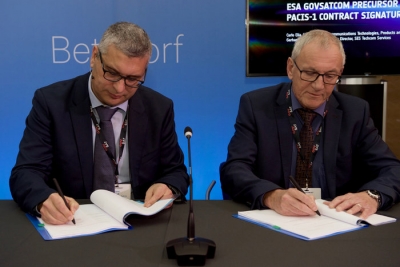ARTES 25 Years of Telecom: Interview with Carlo Elia
As ESA’s umbrella programme for telecom, ARTES, celebrates its 25th year, we will be examining why it was set up, how it and the European satcom environment have evolved, the opportunities and challenges that both face today, and what the future holds.
This week we spoke to Carlo Elia, Head of the Telecommunications Technologies, Products and Systems Department, who told us how his area supports Europe’s industry.
What achievements are you most proud of?
 My department invests more than €100 million in our space industry’s product development every year, supporting the introduction of new innovative technologies that would otherwise not reach the market.
My department invests more than €100 million in our space industry’s product development every year, supporting the introduction of new innovative technologies that would otherwise not reach the market.
ScyLight is an excellent example of this. It was created in 2016 as our dedicated optical communications programme to support what is now recognised as the next big step in satcom systems.
Additionally, we have initiated more than 20 public–private partnerships (PPPs) with many satellite operators and service providers. Our PPP model is recognised as the best mechanism to provide support across the value chain from technology innovation to market utilisation, and is now being replicated in other parts of the world, such as in the US between NASA and commercial entities.
Can you tell us about the opportunities and challenges facing you currently?
The secret lies in the optimum risk allocation. Our approach sees ESA leading on the technology risk, while the private partner deals with the market risk.
The Digital Transformation of business and society is coming, and will revolutionise all areas of both. ESA supports our industry’s ability to adapt, so they can be more agile and act more quickly when faced with rapid market changes.
Realistically, satcoms will represent a small percentage of the Digital Transformation, but that small slice is part of a considerably larger whole that will feature much deeper integration of satellites in telecommunications networks, particularly in the context of 5G. This will result in a much bigger total market than we support today.
What is your vision for your department?
There is little doubt that the current pressure on the conventional satcoms sector will lead to some consolidation, and there is a real opportunity for us to help build a better industry. The ‘New Space’ entrants to our sector are providing constructive disruption of an industry that has changed very little in the last 50 years.
However, we have to remember that many of the New Space companies still have to earn their first €, to emerge, learn and grow. There is a happy medium to be struck between ‘old’ and New Space, and that is what we at ESA are striving to support.
What is the most interesting innovation you've seen from your activities?
There are many.
Programmatically, the most interesting innovations are in the new partnership schemes, such as megaconstellations. Here, ARTES support encompasses a variety of disciplines, from frequency sharing techniques to artificial intelligence autonomous operations, to debris management.
Using a variety of ARTES tools across transversal themes is something that has worked well and we are looking to replicate this in 5G, secure satcoms, and other areas.
Technically, the list is long, but perhaps the most interesting new area is the work we are supporting on Quantum Key Distribution via satellite and optical communications in general – both entirely new disciplines that we are helping to bring to market.


